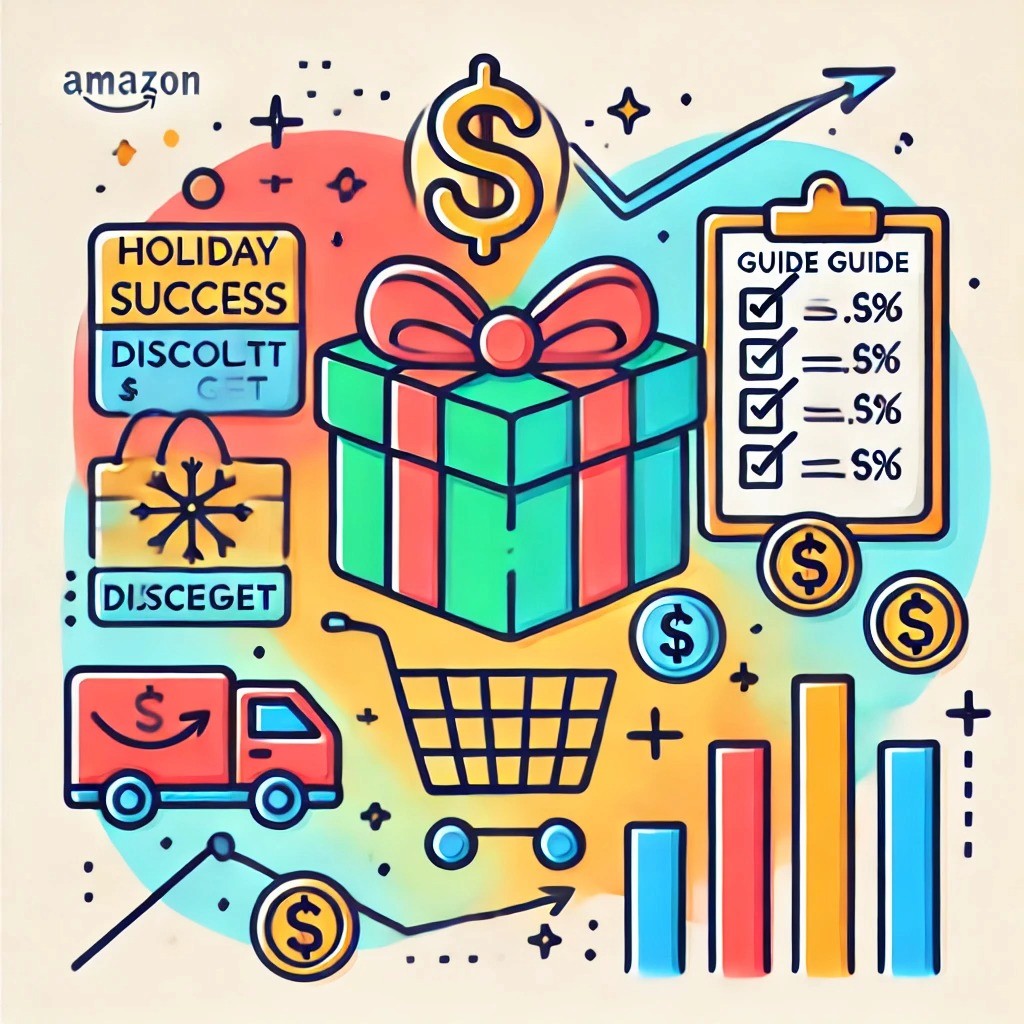Back to Page
Amazon
Amazon Sellers' Guide to Holiday Success on a Budget
Amazon Sellers' Guide to Holiday Success on a Budget


Back to Page
Amazon
Amazon Sellers' Guide to Holiday Success on a Budget

Q4 is the most wonderful time of the year for Amazon sellers, but it can also be the most expensive. Fortunately, there are creative and budget-friendly ways to prepare for the holiday season and boost your sales without breaking the bank. In this article, we'll explore budget-friendly strategies to help Amazon sellers thrive during the holiday season.
Tip #1: Focus only on your five bestsellers

For established brands with a track record of bestsellers, or for new brands looking to identify high-potential products, this strategy involves concentrating your Q4 efforts on a select few items.
When you have a limited budget and time, it's crucial to allocate resources where they'll have the most impact. By focusing on a small selection of products, you can direct your marketing, advertising, and inventory management efforts more effectively.
Identify the products that have historically generated the most revenue for your brand. These are your bestsellers. If you're a new brand without a sales history, choose products that align with current market trends, have positive customer reviews, or show promise based on customer demand.
Ensure they have compelling titles, descriptions, high-quality images, and competitive prices. Craft targeted PPC campaigns and promotions specifically for these items to maximize their visibility and sales potential.
With a focus on a handful of products, your marketing efforts become more streamlined and cost-effective. You can create targeted social media posts, email campaigns, and content that showcase these key products, rather than spreading your resources thinly across your entire catalog.
Tip #2: Make subtle changes to your creatives

Adapting your Amazon creatives to fit seasonal themes like Black Friday, Halloween and Christmas can make a significant impact on your sales. But you don't always need a complete overhaul. Subtle changes can create a fresh, festive vibe while maintaining brand consistency. Here's how to do it:
A+ Content
Swap out your hero banner for a holiday-themed one, such as snowflakes for Christmas or pumpkins for Halloween. Ensure the product remains the focal point.
Integrate holiday-related phrases into your Amazon EBC design and copy while highlighting how your product fits the season. For instance, "Perfect Christmas Gift" or "Spooky Halloween Must-Have."
Images
Showcase your product in a holiday context. For Black Friday, depict it alongside a shopping bag or a "Sale" sign. For Christmas, incorporate festive decorations.
Adjust the color palette of your Amazon infographic images to align with the holiday. Use warm, rich colors for fall and Thanksgiving, or opt for reds and greens for Christmas.
Storefront
Update the Amazon store design with a seasonal design, like presents for Christmas or a haunted house for Halloween. Ensure it complements your branding.
Rearrange the order of featured products to highlight those most relevant to the upcoming holiday. Add temporary promotions or bundle deals.
Posts
Create Amazon posts that tie your products into the holiday spirit. Share gift ideas, decorating tips, or costume suggestions, all while subtly promoting your products.
Encourage customers to share photos of themselves using your products in a seasonal context. Repost these images with appropriate holiday hashtags.
Share the story of how your brand celebrates the season or the inspiration behind your holiday-themed products.
Highlight how your products fit into common holiday traditions or offer unique ways to celebrate.
While embracing seasonal themes, maintain brand consistency. Your customers should recognize your brand's identity, even with seasonal tweaks. Keep your logo, fonts, and color schemes consistent. Monitor the performance of your seasonal creatives through metrics like click-through rates and conversion rates. Experiment with variations and gather customer feedback to fine-tune your approach.
Once the holiday season is over, promptly revert to your regular creatives. Leaving seasonal elements up too long can confuse and deter potential customers. Always adhere to Amazon's guidelines and policies regarding creative content and seasonal promotions. Ensure that your seasonal creatives comply with Amazon's terms.
Tip #3: Less is more when it comes to product copy changes

When it comes to preparing your Amazon listings for the holiday season, you don't always have to start from scratch. If your existing product titles, bullet points, and descriptions are already performing well, the key is to integrate holiday-related keywords strategically. This approach allows you to capitalize on the festive season without the need for a complete content overhaul.
Before diving into keyword integration and Amazon listing optimization, assess your existing product content. Identify the elements that are working well, such as persuasive language, product benefits, and unique selling points. These are the foundations you want to preserve.
Next, compile a list of holiday-related keywords that are relevant to your products and niche. For example, if you sell gifts, consider keywords like "Christmas presents," "holiday gift ideas," or "Black Friday deals."
Now, strategically incorporate these holiday keywords into your existing content:
Title: Include a holiday keyword or two in your product title, but ensure it remains concise and clear. For instance, "Best Christmas Gift: [Your Product Name]."
Bullet points: Within your bullet points, highlight how your product aligns with the holiday season. For example, "Perfect for Thanksgiving gatherings" or "Ideal stocking stuffer for Christmas."
Description: In the product description, elaborate on how your product enhances the holiday experience. Emphasize its suitability as a gift or its relevance to specific holiday activities.
While integrating keywords, prioritize clarity and relevance. Don't force keywords into your content if they don't naturally fit. Ensure that your descriptions remain informative and appealing to customers.
After making these subtle content adjustments, closely monitor your listings' performance. Pay attention to changes in click-through rates and conversion rates. If certain keywords aren't performing as expected, be prepared to adjust and optimize further.
Consider running Amazon PPC campaigns that target specific holiday keywords. This can help increase visibility during peak shopping periods without making extensive changes to your content.
If you're offering holiday discounts, promotions, or bundle deals, make sure these are prominently featured in your content. Shoppers are often on the lookout for holiday savings.
By strategically integrating relevant holiday keywords into your existing titles, bullet points, and descriptions, you can make your listings more appealing to holiday shoppers while preserving what's already working. This approach allows you to stay within budget while capitalizing on the festive spirit that drives holiday sales on Amazon.
Tip #4: Use your Amazon PPC campaigns on a budget

The holiday season is a prime time for Amazon sellers to boost sales and visibility through Pay-Per-Click (PPC) advertising. While effective PPC campaigns can be a game-changer, you don't have to break the bank to prepare for the holiday rush.
Ask your Amazon PPC agency to conduct thorough keyword research and identify high-performing + relevant keywords for your products. Focus on long-tail and specific holiday-related keywords.
Rather than creating new campaigns from scratch, optimize your existing ones. Evaluate your ad groups, keywords, and ad copy to ensure they are holiday-ready.
Set a realistic budget for your holiday PPC campaigns. Consider allocating a higher daily budget during peak shopping days, such as Black Friday and Cyber Monday, and a lower budget on less competitive days.
Implement negative keywords to prevent your ads from appearing in irrelevant searches. This helps save budget and ensures your ads are shown to the most relevant audience.
Opt for an automated bidding strategy if you're unsure about manual bidding. Amazon's algorithms can help optimize your bids for maximum ROI.
Use dayparting to schedule your ads to run during peak shopping hours. This allows you to focus your budget when potential customers are most active.
Conduct A/B tests on ad creatives and copy to identify what resonates best with holiday shoppers. Make data-driven decisions to refine your campaigns.
Consider the type of PPC campaign that aligns with your goals. Sponsored Products are great for individual product promotion, while Sponsored Brands are ideal for showcasing a range of products.
Segment your target audience to create more personalized ads. Tailor your messaging and offers to different customer segments for higher engagement.
Keep a close eye on your campaign performance throughout the holiday season. Adjust bids, keywords, and budgets as needed to optimize results.
Update your ad copy to reflect the holiday season. Include holiday-specific language and promotions to capture the festive spirit.
Amazon allows you to schedule your ads for specific dates and times. Use this feature to align with holiday sales events.
Concentrate your budget on promoting your best-selling and high-margin products. These are likely to yield the best returns during the holidays.
Measure the Return on Investment (ROI) for each campaign. Adjust your strategies based on which campaigns are delivering the best results.
By implementing these budget-conscious strategies, you can effectively prepare your Amazon PPC campaigns for the holiday season. Remember that a well-optimized, targeted campaign can yield impressive results without the need for extravagant spending. Stay agile, analyze data, and refine your approach to make the most of the festive shopping frenzy on Amazon.
Tip #5: Leverage user generated content for your social media

Encouraging user-generated content is a cost-effective and impactful approach to social media marketing.
Start by crafting a unique and memorable branded hashtag that aligns with your brand and the campaign's theme. Make it short, catchy, and easy to remember. Promote this hashtag across your social media channels and marketing materials. Provide clear instructions and guidelines to your audience on what type of content you're looking for. Specify the theme, content format (e.g., photos, videos, stories), and any relevant rules or restrictions.
Regularly feature UGC on your social media profiles. Highlight how real customers are using your products or services in their daily lives. Share their stories, testimonials, or creative interpretations. Organize contests or challenges that encourage users to create and share content related to your brand or products. Offer enticing prizes or incentives to motivate participation.
When users contribute content, engage with them by liking, commenting, and sharing their posts. Show appreciation for their creativity and contributions, building a sense of community. Utilize UGC in your infographics, storefronts, and Posts. Authentic content from real customers can significantly boost your credibility and trustworthiness.
Track the performance of your UGC campaigns using social media analytics. Learn from the data and continually refine your UGC strategies for maximum impact.
Tip #6: Collaborate with micro influencers

Collaborating with micro-influencers can be a cost-effective strategy that yields significant results. Here's how you can successfully collaborate with micro-influencers to promote your brand
Start by researching and identifying micro-influencers who align with your brand's values, niche, and target audience. Look for individuals with a genuine and engaged following.
Clearly outline your campaign objectives. Whether it's to increase brand awareness, drive website traffic, or boost sales, having well-defined goals will guide your collaboration efforts.
Approach potential micro-influencers with a compelling value proposition. Highlight how the collaboration benefits both parties, emphasizing the value they'll receive.
Authenticity is key when engaging with micro-influencers. Reach out personally and express genuine interest in their content and audience.
Show your support by actively engaging with their social media content. Like, comment, and share their posts to build rapport.
Ensure that the products or services you're offering for collaboration align with the micro-influencer's content and audience. Authenticity is crucial for a successful partnership.
Discuss compensation transparently. Compensation can vary from product samples and discounts to monetary payments, depending on the influencer's reach and engagement.
Establish clear guidelines and expectations for the collaboration. This includes content creation deadlines, post frequency, and disclosure of the partnership.
Micro-influencers have a unique voice and style. Allow them creative freedom to craft content that resonates with their audience while aligning with your brand's messaging.
Provide comprehensive content briefs that outline the key messages, hashtags, and visuals you'd like the influencer to incorporate in their posts.
Use tracking tools to monitor the performance of influencer posts. Track metrics such as reach, engagement, website visits, and conversions.
Building lasting relationships with micro-influencers can lead to ongoing collaborations. Nurture these relationships by maintaining open communication and showing appreciation.
Tip #7: Run free email campaigns using Manage Your Customer engagement

Amazon offers a powerful tool known as "Manage Your Customer Engagement" to help registered brands with Amazon Stores pages engage with their followers effectively. This tool allows brands to create and send email campaigns to their followers, enhancing customer engagement during the holiday season and beyond.
Eligibility: To be eligible for "Manage Your Customer Engagement," your brand must be registered and have an Amazon Stores page with followers. If your brand is not already registered, you can check your eligibility and register through the Amazon Brand Registry.
Setting up and managing your customer engagement
Create a storefront page: Ensure that you have an Amazon Stores page for your brand, where you can showcase your products and connect with your audience. Amazon Stores is a free self-service product that offers creative options for brand promotion.
Prepare quality content: Create a post on your Store page featuring quality content to attract and increase your followers. This content should be engaging and relevant to your brand and products.
Design an email campaign: Within the "Manage Your Customer Engagement" tool, you can design an email campaign to reach your followers. Here are the steps to create an email campaign:
Step 1 – Upload your brand logo: Your logo must have a horizontal layout (3:1 or narrower) and can have a black or white background (JPG) or a transparent background (PNG).
Step 2 – Add a product: Include a recently launched product that has become available for purchase on Amazon within the last six months.
Step 3 – Select a supporting image: Choose or upload a lifestyle image or an image that explains the benefits of the product. Ensure that the image adheres to Amazon's product image requirements.
Step 4 – Schedule your campaign: Select the time range for sending your campaign. The campaign will run over five days from Monday to Friday.
Step 5 - campaign approval: Amazon's moderation team will review your campaign to ensure it meets their content requirements. It may take a minimum of 72 hours for your image assets to be reviewed.
Pro-tip: Plan your campaign schedule carefully to allow ample time for reviews. If your campaign is rejected, you will need to create a new campaign that complies with Amazon's content requirements.
By effectively utilizing the "Manage Your Customer Engagement" tool on Amazon, you can engage with your audience, share valuable content, and drive sales during the holiday season without exceeding your budget.
Smart strategies, big savings
By implementing these specific budget-conscious tactics, Amazon sellers can prepare effectively for Q4 without straining their finances. Creativity, collaboration, and smart resource allocation can make all the difference in achieving holiday season success on a budget.
Our team of Amazon sales consultants understands the challenges you face during the holiday season and can provide tailored solutions to maximize your sales potential while optimizing your budget. From crafting compelling product listings to creating eye-catching visuals and implementing effective marketing campaigns, eStore Factory has the expertise to help you succeed.
Q4 is the most wonderful time of the year for Amazon sellers, but it can also be the most expensive. Fortunately, there are creative and budget-friendly ways to prepare for the holiday season and boost your sales without breaking the bank. In this article, we'll explore budget-friendly strategies to help Amazon sellers thrive during the holiday season.
Tip #1: Focus only on your five bestsellers

For established brands with a track record of bestsellers, or for new brands looking to identify high-potential products, this strategy involves concentrating your Q4 efforts on a select few items.
When you have a limited budget and time, it's crucial to allocate resources where they'll have the most impact. By focusing on a small selection of products, you can direct your marketing, advertising, and inventory management efforts more effectively.
Identify the products that have historically generated the most revenue for your brand. These are your bestsellers. If you're a new brand without a sales history, choose products that align with current market trends, have positive customer reviews, or show promise based on customer demand.
Ensure they have compelling titles, descriptions, high-quality images, and competitive prices. Craft targeted PPC campaigns and promotions specifically for these items to maximize their visibility and sales potential.
With a focus on a handful of products, your marketing efforts become more streamlined and cost-effective. You can create targeted social media posts, email campaigns, and content that showcase these key products, rather than spreading your resources thinly across your entire catalog.
Tip #2: Make subtle changes to your creatives

Adapting your Amazon creatives to fit seasonal themes like Black Friday, Halloween and Christmas can make a significant impact on your sales. But you don't always need a complete overhaul. Subtle changes can create a fresh, festive vibe while maintaining brand consistency. Here's how to do it:
A+ Content
Swap out your hero banner for a holiday-themed one, such as snowflakes for Christmas or pumpkins for Halloween. Ensure the product remains the focal point.
Integrate holiday-related phrases into your Amazon EBC design and copy while highlighting how your product fits the season. For instance, "Perfect Christmas Gift" or "Spooky Halloween Must-Have."
Images
Showcase your product in a holiday context. For Black Friday, depict it alongside a shopping bag or a "Sale" sign. For Christmas, incorporate festive decorations.
Adjust the color palette of your Amazon infographic images to align with the holiday. Use warm, rich colors for fall and Thanksgiving, or opt for reds and greens for Christmas.
Storefront
Update the Amazon store design with a seasonal design, like presents for Christmas or a haunted house for Halloween. Ensure it complements your branding.
Rearrange the order of featured products to highlight those most relevant to the upcoming holiday. Add temporary promotions or bundle deals.
Posts
Create Amazon posts that tie your products into the holiday spirit. Share gift ideas, decorating tips, or costume suggestions, all while subtly promoting your products.
Encourage customers to share photos of themselves using your products in a seasonal context. Repost these images with appropriate holiday hashtags.
Share the story of how your brand celebrates the season or the inspiration behind your holiday-themed products.
Highlight how your products fit into common holiday traditions or offer unique ways to celebrate.
While embracing seasonal themes, maintain brand consistency. Your customers should recognize your brand's identity, even with seasonal tweaks. Keep your logo, fonts, and color schemes consistent. Monitor the performance of your seasonal creatives through metrics like click-through rates and conversion rates. Experiment with variations and gather customer feedback to fine-tune your approach.
Once the holiday season is over, promptly revert to your regular creatives. Leaving seasonal elements up too long can confuse and deter potential customers. Always adhere to Amazon's guidelines and policies regarding creative content and seasonal promotions. Ensure that your seasonal creatives comply with Amazon's terms.
Tip #3: Less is more when it comes to product copy changes

When it comes to preparing your Amazon listings for the holiday season, you don't always have to start from scratch. If your existing product titles, bullet points, and descriptions are already performing well, the key is to integrate holiday-related keywords strategically. This approach allows you to capitalize on the festive season without the need for a complete content overhaul.
Before diving into keyword integration and Amazon listing optimization, assess your existing product content. Identify the elements that are working well, such as persuasive language, product benefits, and unique selling points. These are the foundations you want to preserve.
Next, compile a list of holiday-related keywords that are relevant to your products and niche. For example, if you sell gifts, consider keywords like "Christmas presents," "holiday gift ideas," or "Black Friday deals."
Now, strategically incorporate these holiday keywords into your existing content:
Title: Include a holiday keyword or two in your product title, but ensure it remains concise and clear. For instance, "Best Christmas Gift: [Your Product Name]."
Bullet points: Within your bullet points, highlight how your product aligns with the holiday season. For example, "Perfect for Thanksgiving gatherings" or "Ideal stocking stuffer for Christmas."
Description: In the product description, elaborate on how your product enhances the holiday experience. Emphasize its suitability as a gift or its relevance to specific holiday activities.
While integrating keywords, prioritize clarity and relevance. Don't force keywords into your content if they don't naturally fit. Ensure that your descriptions remain informative and appealing to customers.
After making these subtle content adjustments, closely monitor your listings' performance. Pay attention to changes in click-through rates and conversion rates. If certain keywords aren't performing as expected, be prepared to adjust and optimize further.
Consider running Amazon PPC campaigns that target specific holiday keywords. This can help increase visibility during peak shopping periods without making extensive changes to your content.
If you're offering holiday discounts, promotions, or bundle deals, make sure these are prominently featured in your content. Shoppers are often on the lookout for holiday savings.
By strategically integrating relevant holiday keywords into your existing titles, bullet points, and descriptions, you can make your listings more appealing to holiday shoppers while preserving what's already working. This approach allows you to stay within budget while capitalizing on the festive spirit that drives holiday sales on Amazon.
Tip #4: Use your Amazon PPC campaigns on a budget

The holiday season is a prime time for Amazon sellers to boost sales and visibility through Pay-Per-Click (PPC) advertising. While effective PPC campaigns can be a game-changer, you don't have to break the bank to prepare for the holiday rush.
Ask your Amazon PPC agency to conduct thorough keyword research and identify high-performing + relevant keywords for your products. Focus on long-tail and specific holiday-related keywords.
Rather than creating new campaigns from scratch, optimize your existing ones. Evaluate your ad groups, keywords, and ad copy to ensure they are holiday-ready.
Set a realistic budget for your holiday PPC campaigns. Consider allocating a higher daily budget during peak shopping days, such as Black Friday and Cyber Monday, and a lower budget on less competitive days.
Implement negative keywords to prevent your ads from appearing in irrelevant searches. This helps save budget and ensures your ads are shown to the most relevant audience.
Opt for an automated bidding strategy if you're unsure about manual bidding. Amazon's algorithms can help optimize your bids for maximum ROI.
Use dayparting to schedule your ads to run during peak shopping hours. This allows you to focus your budget when potential customers are most active.
Conduct A/B tests on ad creatives and copy to identify what resonates best with holiday shoppers. Make data-driven decisions to refine your campaigns.
Consider the type of PPC campaign that aligns with your goals. Sponsored Products are great for individual product promotion, while Sponsored Brands are ideal for showcasing a range of products.
Segment your target audience to create more personalized ads. Tailor your messaging and offers to different customer segments for higher engagement.
Keep a close eye on your campaign performance throughout the holiday season. Adjust bids, keywords, and budgets as needed to optimize results.
Update your ad copy to reflect the holiday season. Include holiday-specific language and promotions to capture the festive spirit.
Amazon allows you to schedule your ads for specific dates and times. Use this feature to align with holiday sales events.
Concentrate your budget on promoting your best-selling and high-margin products. These are likely to yield the best returns during the holidays.
Measure the Return on Investment (ROI) for each campaign. Adjust your strategies based on which campaigns are delivering the best results.
By implementing these budget-conscious strategies, you can effectively prepare your Amazon PPC campaigns for the holiday season. Remember that a well-optimized, targeted campaign can yield impressive results without the need for extravagant spending. Stay agile, analyze data, and refine your approach to make the most of the festive shopping frenzy on Amazon.
Tip #5: Leverage user generated content for your social media

Encouraging user-generated content is a cost-effective and impactful approach to social media marketing.
Start by crafting a unique and memorable branded hashtag that aligns with your brand and the campaign's theme. Make it short, catchy, and easy to remember. Promote this hashtag across your social media channels and marketing materials. Provide clear instructions and guidelines to your audience on what type of content you're looking for. Specify the theme, content format (e.g., photos, videos, stories), and any relevant rules or restrictions.
Regularly feature UGC on your social media profiles. Highlight how real customers are using your products or services in their daily lives. Share their stories, testimonials, or creative interpretations. Organize contests or challenges that encourage users to create and share content related to your brand or products. Offer enticing prizes or incentives to motivate participation.
When users contribute content, engage with them by liking, commenting, and sharing their posts. Show appreciation for their creativity and contributions, building a sense of community. Utilize UGC in your infographics, storefronts, and Posts. Authentic content from real customers can significantly boost your credibility and trustworthiness.
Track the performance of your UGC campaigns using social media analytics. Learn from the data and continually refine your UGC strategies for maximum impact.
Tip #6: Collaborate with micro influencers

Collaborating with micro-influencers can be a cost-effective strategy that yields significant results. Here's how you can successfully collaborate with micro-influencers to promote your brand
Start by researching and identifying micro-influencers who align with your brand's values, niche, and target audience. Look for individuals with a genuine and engaged following.
Clearly outline your campaign objectives. Whether it's to increase brand awareness, drive website traffic, or boost sales, having well-defined goals will guide your collaboration efforts.
Approach potential micro-influencers with a compelling value proposition. Highlight how the collaboration benefits both parties, emphasizing the value they'll receive.
Authenticity is key when engaging with micro-influencers. Reach out personally and express genuine interest in their content and audience.
Show your support by actively engaging with their social media content. Like, comment, and share their posts to build rapport.
Ensure that the products or services you're offering for collaboration align with the micro-influencer's content and audience. Authenticity is crucial for a successful partnership.
Discuss compensation transparently. Compensation can vary from product samples and discounts to monetary payments, depending on the influencer's reach and engagement.
Establish clear guidelines and expectations for the collaboration. This includes content creation deadlines, post frequency, and disclosure of the partnership.
Micro-influencers have a unique voice and style. Allow them creative freedom to craft content that resonates with their audience while aligning with your brand's messaging.
Provide comprehensive content briefs that outline the key messages, hashtags, and visuals you'd like the influencer to incorporate in their posts.
Use tracking tools to monitor the performance of influencer posts. Track metrics such as reach, engagement, website visits, and conversions.
Building lasting relationships with micro-influencers can lead to ongoing collaborations. Nurture these relationships by maintaining open communication and showing appreciation.
Tip #7: Run free email campaigns using Manage Your Customer engagement

Amazon offers a powerful tool known as "Manage Your Customer Engagement" to help registered brands with Amazon Stores pages engage with their followers effectively. This tool allows brands to create and send email campaigns to their followers, enhancing customer engagement during the holiday season and beyond.
Eligibility: To be eligible for "Manage Your Customer Engagement," your brand must be registered and have an Amazon Stores page with followers. If your brand is not already registered, you can check your eligibility and register through the Amazon Brand Registry.
Setting up and managing your customer engagement
Create a storefront page: Ensure that you have an Amazon Stores page for your brand, where you can showcase your products and connect with your audience. Amazon Stores is a free self-service product that offers creative options for brand promotion.
Prepare quality content: Create a post on your Store page featuring quality content to attract and increase your followers. This content should be engaging and relevant to your brand and products.
Design an email campaign: Within the "Manage Your Customer Engagement" tool, you can design an email campaign to reach your followers. Here are the steps to create an email campaign:
Step 1 – Upload your brand logo: Your logo must have a horizontal layout (3:1 or narrower) and can have a black or white background (JPG) or a transparent background (PNG).
Step 2 – Add a product: Include a recently launched product that has become available for purchase on Amazon within the last six months.
Step 3 – Select a supporting image: Choose or upload a lifestyle image or an image that explains the benefits of the product. Ensure that the image adheres to Amazon's product image requirements.
Step 4 – Schedule your campaign: Select the time range for sending your campaign. The campaign will run over five days from Monday to Friday.
Step 5 - campaign approval: Amazon's moderation team will review your campaign to ensure it meets their content requirements. It may take a minimum of 72 hours for your image assets to be reviewed.
Pro-tip: Plan your campaign schedule carefully to allow ample time for reviews. If your campaign is rejected, you will need to create a new campaign that complies with Amazon's content requirements.
By effectively utilizing the "Manage Your Customer Engagement" tool on Amazon, you can engage with your audience, share valuable content, and drive sales during the holiday season without exceeding your budget.
Smart strategies, big savings
By implementing these specific budget-conscious tactics, Amazon sellers can prepare effectively for Q4 without straining their finances. Creativity, collaboration, and smart resource allocation can make all the difference in achieving holiday season success on a budget.
Our team of Amazon sales consultants understands the challenges you face during the holiday season and can provide tailored solutions to maximize your sales potential while optimizing your budget. From crafting compelling product listings to creating eye-catching visuals and implementing effective marketing campaigns, eStore Factory has the expertise to help you succeed.
Q4 is the most wonderful time of the year for Amazon sellers, but it can also be the most expensive. Fortunately, there are creative and budget-friendly ways to prepare for the holiday season and boost your sales without breaking the bank. In this article, we'll explore budget-friendly strategies to help Amazon sellers thrive during the holiday season.
Tip #1: Focus only on your five bestsellers

For established brands with a track record of bestsellers, or for new brands looking to identify high-potential products, this strategy involves concentrating your Q4 efforts on a select few items.
When you have a limited budget and time, it's crucial to allocate resources where they'll have the most impact. By focusing on a small selection of products, you can direct your marketing, advertising, and inventory management efforts more effectively.
Identify the products that have historically generated the most revenue for your brand. These are your bestsellers. If you're a new brand without a sales history, choose products that align with current market trends, have positive customer reviews, or show promise based on customer demand.
Ensure they have compelling titles, descriptions, high-quality images, and competitive prices. Craft targeted PPC campaigns and promotions specifically for these items to maximize their visibility and sales potential.
With a focus on a handful of products, your marketing efforts become more streamlined and cost-effective. You can create targeted social media posts, email campaigns, and content that showcase these key products, rather than spreading your resources thinly across your entire catalog.
Tip #2: Make subtle changes to your creatives

Adapting your Amazon creatives to fit seasonal themes like Black Friday, Halloween and Christmas can make a significant impact on your sales. But you don't always need a complete overhaul. Subtle changes can create a fresh, festive vibe while maintaining brand consistency. Here's how to do it:
A+ Content
Swap out your hero banner for a holiday-themed one, such as snowflakes for Christmas or pumpkins for Halloween. Ensure the product remains the focal point.
Integrate holiday-related phrases into your Amazon EBC design and copy while highlighting how your product fits the season. For instance, "Perfect Christmas Gift" or "Spooky Halloween Must-Have."
Images
Showcase your product in a holiday context. For Black Friday, depict it alongside a shopping bag or a "Sale" sign. For Christmas, incorporate festive decorations.
Adjust the color palette of your Amazon infographic images to align with the holiday. Use warm, rich colors for fall and Thanksgiving, or opt for reds and greens for Christmas.
Storefront
Update the Amazon store design with a seasonal design, like presents for Christmas or a haunted house for Halloween. Ensure it complements your branding.
Rearrange the order of featured products to highlight those most relevant to the upcoming holiday. Add temporary promotions or bundle deals.
Posts
Create Amazon posts that tie your products into the holiday spirit. Share gift ideas, decorating tips, or costume suggestions, all while subtly promoting your products.
Encourage customers to share photos of themselves using your products in a seasonal context. Repost these images with appropriate holiday hashtags.
Share the story of how your brand celebrates the season or the inspiration behind your holiday-themed products.
Highlight how your products fit into common holiday traditions or offer unique ways to celebrate.
While embracing seasonal themes, maintain brand consistency. Your customers should recognize your brand's identity, even with seasonal tweaks. Keep your logo, fonts, and color schemes consistent. Monitor the performance of your seasonal creatives through metrics like click-through rates and conversion rates. Experiment with variations and gather customer feedback to fine-tune your approach.
Once the holiday season is over, promptly revert to your regular creatives. Leaving seasonal elements up too long can confuse and deter potential customers. Always adhere to Amazon's guidelines and policies regarding creative content and seasonal promotions. Ensure that your seasonal creatives comply with Amazon's terms.
Tip #3: Less is more when it comes to product copy changes

When it comes to preparing your Amazon listings for the holiday season, you don't always have to start from scratch. If your existing product titles, bullet points, and descriptions are already performing well, the key is to integrate holiday-related keywords strategically. This approach allows you to capitalize on the festive season without the need for a complete content overhaul.
Before diving into keyword integration and Amazon listing optimization, assess your existing product content. Identify the elements that are working well, such as persuasive language, product benefits, and unique selling points. These are the foundations you want to preserve.
Next, compile a list of holiday-related keywords that are relevant to your products and niche. For example, if you sell gifts, consider keywords like "Christmas presents," "holiday gift ideas," or "Black Friday deals."
Now, strategically incorporate these holiday keywords into your existing content:
Title: Include a holiday keyword or two in your product title, but ensure it remains concise and clear. For instance, "Best Christmas Gift: [Your Product Name]."
Bullet points: Within your bullet points, highlight how your product aligns with the holiday season. For example, "Perfect for Thanksgiving gatherings" or "Ideal stocking stuffer for Christmas."
Description: In the product description, elaborate on how your product enhances the holiday experience. Emphasize its suitability as a gift or its relevance to specific holiday activities.
While integrating keywords, prioritize clarity and relevance. Don't force keywords into your content if they don't naturally fit. Ensure that your descriptions remain informative and appealing to customers.
After making these subtle content adjustments, closely monitor your listings' performance. Pay attention to changes in click-through rates and conversion rates. If certain keywords aren't performing as expected, be prepared to adjust and optimize further.
Consider running Amazon PPC campaigns that target specific holiday keywords. This can help increase visibility during peak shopping periods without making extensive changes to your content.
If you're offering holiday discounts, promotions, or bundle deals, make sure these are prominently featured in your content. Shoppers are often on the lookout for holiday savings.
By strategically integrating relevant holiday keywords into your existing titles, bullet points, and descriptions, you can make your listings more appealing to holiday shoppers while preserving what's already working. This approach allows you to stay within budget while capitalizing on the festive spirit that drives holiday sales on Amazon.
Tip #4: Use your Amazon PPC campaigns on a budget

The holiday season is a prime time for Amazon sellers to boost sales and visibility through Pay-Per-Click (PPC) advertising. While effective PPC campaigns can be a game-changer, you don't have to break the bank to prepare for the holiday rush.
Ask your Amazon PPC agency to conduct thorough keyword research and identify high-performing + relevant keywords for your products. Focus on long-tail and specific holiday-related keywords.
Rather than creating new campaigns from scratch, optimize your existing ones. Evaluate your ad groups, keywords, and ad copy to ensure they are holiday-ready.
Set a realistic budget for your holiday PPC campaigns. Consider allocating a higher daily budget during peak shopping days, such as Black Friday and Cyber Monday, and a lower budget on less competitive days.
Implement negative keywords to prevent your ads from appearing in irrelevant searches. This helps save budget and ensures your ads are shown to the most relevant audience.
Opt for an automated bidding strategy if you're unsure about manual bidding. Amazon's algorithms can help optimize your bids for maximum ROI.
Use dayparting to schedule your ads to run during peak shopping hours. This allows you to focus your budget when potential customers are most active.
Conduct A/B tests on ad creatives and copy to identify what resonates best with holiday shoppers. Make data-driven decisions to refine your campaigns.
Consider the type of PPC campaign that aligns with your goals. Sponsored Products are great for individual product promotion, while Sponsored Brands are ideal for showcasing a range of products.
Segment your target audience to create more personalized ads. Tailor your messaging and offers to different customer segments for higher engagement.
Keep a close eye on your campaign performance throughout the holiday season. Adjust bids, keywords, and budgets as needed to optimize results.
Update your ad copy to reflect the holiday season. Include holiday-specific language and promotions to capture the festive spirit.
Amazon allows you to schedule your ads for specific dates and times. Use this feature to align with holiday sales events.
Concentrate your budget on promoting your best-selling and high-margin products. These are likely to yield the best returns during the holidays.
Measure the Return on Investment (ROI) for each campaign. Adjust your strategies based on which campaigns are delivering the best results.
By implementing these budget-conscious strategies, you can effectively prepare your Amazon PPC campaigns for the holiday season. Remember that a well-optimized, targeted campaign can yield impressive results without the need for extravagant spending. Stay agile, analyze data, and refine your approach to make the most of the festive shopping frenzy on Amazon.
Tip #5: Leverage user generated content for your social media

Encouraging user-generated content is a cost-effective and impactful approach to social media marketing.
Start by crafting a unique and memorable branded hashtag that aligns with your brand and the campaign's theme. Make it short, catchy, and easy to remember. Promote this hashtag across your social media channels and marketing materials. Provide clear instructions and guidelines to your audience on what type of content you're looking for. Specify the theme, content format (e.g., photos, videos, stories), and any relevant rules or restrictions.
Regularly feature UGC on your social media profiles. Highlight how real customers are using your products or services in their daily lives. Share their stories, testimonials, or creative interpretations. Organize contests or challenges that encourage users to create and share content related to your brand or products. Offer enticing prizes or incentives to motivate participation.
When users contribute content, engage with them by liking, commenting, and sharing their posts. Show appreciation for their creativity and contributions, building a sense of community. Utilize UGC in your infographics, storefronts, and Posts. Authentic content from real customers can significantly boost your credibility and trustworthiness.
Track the performance of your UGC campaigns using social media analytics. Learn from the data and continually refine your UGC strategies for maximum impact.
Tip #6: Collaborate with micro influencers

Collaborating with micro-influencers can be a cost-effective strategy that yields significant results. Here's how you can successfully collaborate with micro-influencers to promote your brand
Start by researching and identifying micro-influencers who align with your brand's values, niche, and target audience. Look for individuals with a genuine and engaged following.
Clearly outline your campaign objectives. Whether it's to increase brand awareness, drive website traffic, or boost sales, having well-defined goals will guide your collaboration efforts.
Approach potential micro-influencers with a compelling value proposition. Highlight how the collaboration benefits both parties, emphasizing the value they'll receive.
Authenticity is key when engaging with micro-influencers. Reach out personally and express genuine interest in their content and audience.
Show your support by actively engaging with their social media content. Like, comment, and share their posts to build rapport.
Ensure that the products or services you're offering for collaboration align with the micro-influencer's content and audience. Authenticity is crucial for a successful partnership.
Discuss compensation transparently. Compensation can vary from product samples and discounts to monetary payments, depending on the influencer's reach and engagement.
Establish clear guidelines and expectations for the collaboration. This includes content creation deadlines, post frequency, and disclosure of the partnership.
Micro-influencers have a unique voice and style. Allow them creative freedom to craft content that resonates with their audience while aligning with your brand's messaging.
Provide comprehensive content briefs that outline the key messages, hashtags, and visuals you'd like the influencer to incorporate in their posts.
Use tracking tools to monitor the performance of influencer posts. Track metrics such as reach, engagement, website visits, and conversions.
Building lasting relationships with micro-influencers can lead to ongoing collaborations. Nurture these relationships by maintaining open communication and showing appreciation.
Tip #7: Run free email campaigns using Manage Your Customer engagement

Amazon offers a powerful tool known as "Manage Your Customer Engagement" to help registered brands with Amazon Stores pages engage with their followers effectively. This tool allows brands to create and send email campaigns to their followers, enhancing customer engagement during the holiday season and beyond.
Eligibility: To be eligible for "Manage Your Customer Engagement," your brand must be registered and have an Amazon Stores page with followers. If your brand is not already registered, you can check your eligibility and register through the Amazon Brand Registry.
Setting up and managing your customer engagement
Create a storefront page: Ensure that you have an Amazon Stores page for your brand, where you can showcase your products and connect with your audience. Amazon Stores is a free self-service product that offers creative options for brand promotion.
Prepare quality content: Create a post on your Store page featuring quality content to attract and increase your followers. This content should be engaging and relevant to your brand and products.
Design an email campaign: Within the "Manage Your Customer Engagement" tool, you can design an email campaign to reach your followers. Here are the steps to create an email campaign:
Step 1 – Upload your brand logo: Your logo must have a horizontal layout (3:1 or narrower) and can have a black or white background (JPG) or a transparent background (PNG).
Step 2 – Add a product: Include a recently launched product that has become available for purchase on Amazon within the last six months.
Step 3 – Select a supporting image: Choose or upload a lifestyle image or an image that explains the benefits of the product. Ensure that the image adheres to Amazon's product image requirements.
Step 4 – Schedule your campaign: Select the time range for sending your campaign. The campaign will run over five days from Monday to Friday.
Step 5 - campaign approval: Amazon's moderation team will review your campaign to ensure it meets their content requirements. It may take a minimum of 72 hours for your image assets to be reviewed.
Pro-tip: Plan your campaign schedule carefully to allow ample time for reviews. If your campaign is rejected, you will need to create a new campaign that complies with Amazon's content requirements.
By effectively utilizing the "Manage Your Customer Engagement" tool on Amazon, you can engage with your audience, share valuable content, and drive sales during the holiday season without exceeding your budget.
Smart strategies, big savings
By implementing these specific budget-conscious tactics, Amazon sellers can prepare effectively for Q4 without straining their finances. Creativity, collaboration, and smart resource allocation can make all the difference in achieving holiday season success on a budget.
Our team of Amazon sales consultants understands the challenges you face during the holiday season and can provide tailored solutions to maximize your sales potential while optimizing your budget. From crafting compelling product listings to creating eye-catching visuals and implementing effective marketing campaigns, eStore Factory has the expertise to help you succeed.










